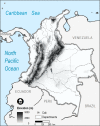Intra- and interseasonal autoregressive prediction of dengue outbreaks using local weather and regional climate for a tropical environment in Colombia
- PMID: 24957546
- PMCID: PMC4155567
- DOI: 10.4269/ajtmh.13-0303
Intra- and interseasonal autoregressive prediction of dengue outbreaks using local weather and regional climate for a tropical environment in Colombia
Abstract
Dengue fever transmission results from complex interactions between the virus, human hosts, and mosquito vectors-all of which are influenced by environmental factors. Predictive models of dengue incidence rate, based on local weather and regional climate parameters, could benefit disease mitigation efforts. Time series of epidemiological and meteorological data for the urban environment of Cali, Colombia are analyzed from January of 2000 to December of 2011. Significant dengue outbreaks generally occur during warm-dry periods with extreme daily temperatures confined between 18°C and 32°C--the optimal range for mosquito survival and viral transmission. Two environment-based, multivariate, autoregressive forecast models are developed that allow dengue outbreaks to be anticipated from 2 weeks to 6 months in advance. These models have the potential to enhance existing dengue early warning systems, ultimately supporting public health decisions on the timing and scale of vector control efforts.
© The American Society of Tropical Medicine and Hygiene.
Figures








References
-
- World Health Organization Dengue and Severe Dengue. Fact Sheet No. 117. World Health Organization. 2012. http://www.who.int/mediacentre/factsheets/fs117/en/ Available at. Accessed March 20, 2013.
-
- Ocampo CB, Salazar-Terreros MJ, Mina NJ, McAllister J, Brogdon W. Insecticide resistance status of Aedes aegypti in 10 localities in Colombia. Acta Trop. 2011;118:37–44. - PubMed
-
- World Health Organization . Dengue: Guidelines for Diagnosis, Treatment, Prevention and Control—New Edition. Geneva: World Health Organization; 2009. - PubMed
Publication types
MeSH terms
LinkOut - more resources
Full Text Sources
Other Literature Sources
Medical

